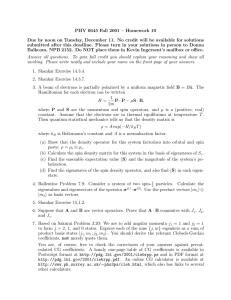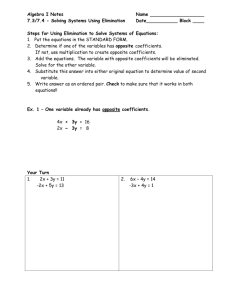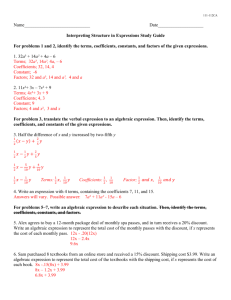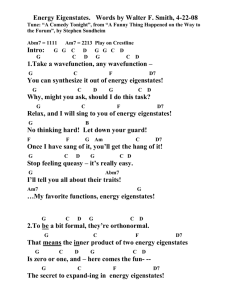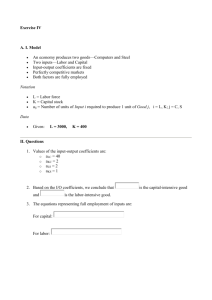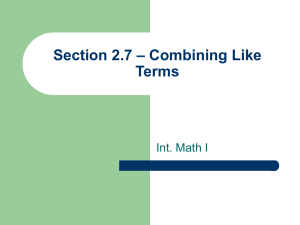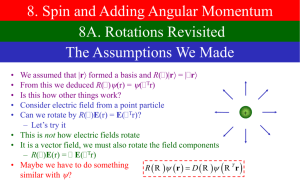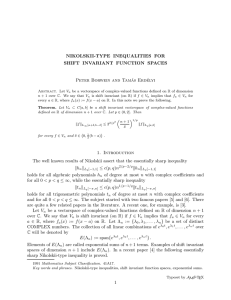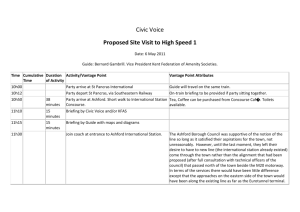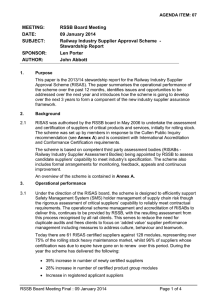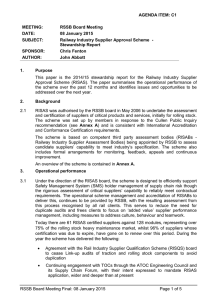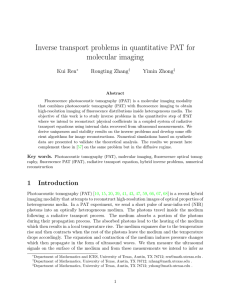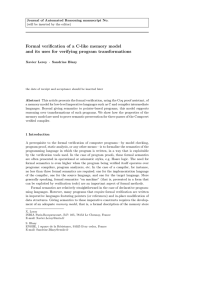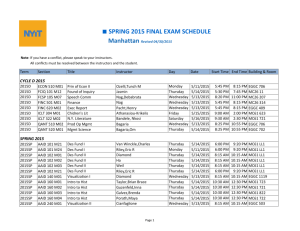Lecture 30
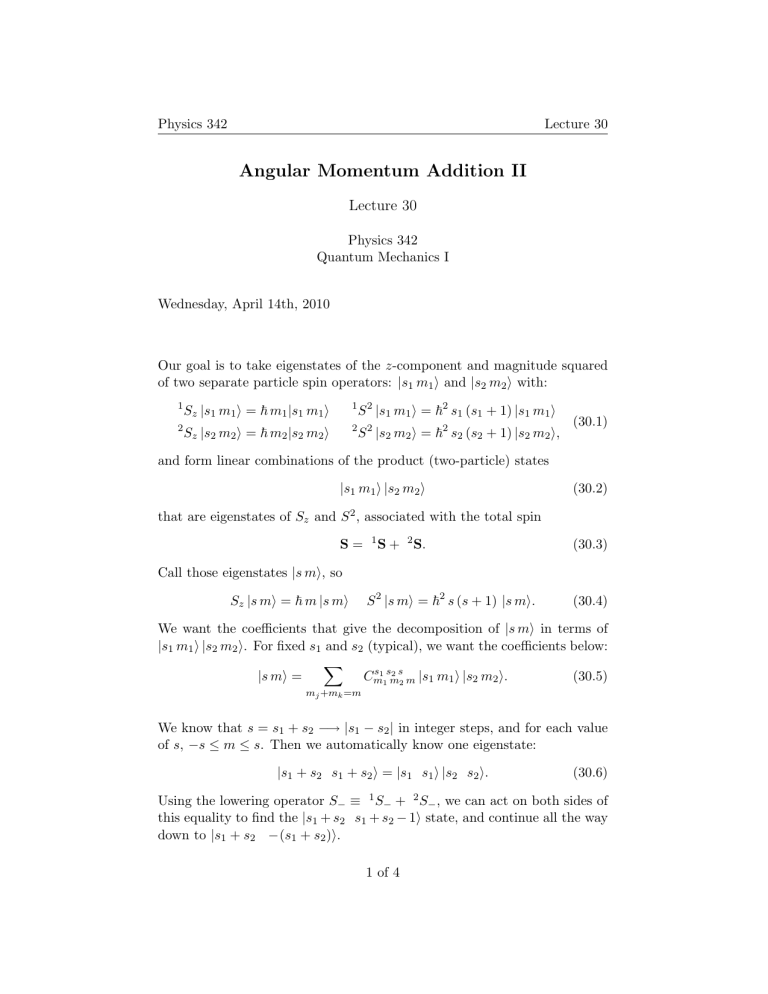
Physics 342
Angular Momentum Addition II
Lecture 30
Physics 342
Quantum Mechanics I
Wednesday, April 14th, 2010
Lecture 30
Our goal is to take eigenstates of the z -component and magnitude squared of two separate particle spin operators: | s
1 m
1 i and | s
2 m
2 i with:
1 S z
| s
1 m
1 i =
~ m
1
| s
1 m
1 i
2 S z
| s
2 m
2 i =
~ m
2
| s
2 m
2 i
1 S
2 S
2
2
| s
1
| s
2 m
1 i = m
2 i =
~
2
~
2 s
1 s
2
( s
1
( s
2
+ 1) | s
1
+ 1) | s
2 m
1 m
2 and form linear combinations of the product (two-particle) states i i ,
(30.1)
| s
1 m
1 i | s
2 m
2 i that are eigenstates of S z and S 2 , associated with the total spin
S
= 1
S
+ 2
S
.
(30.2)
(30.3)
Call those eigenstates | s m i , so
S z
| s m i =
~ m | s m i S 2 | s m i =
~
2 s ( s + 1) | s m i .
(30.4)
We want the coefficients that give the decomposition of | s m i in terms of
| s
1 m
1 i | s
2 m
2 i . For fixed s
1 and s
2
(typical), we want the coefficients below:
| s m i = X m j
+ m k
= m
C s
1 s
2 s m
1 m
2 m
| s
1 m
1 i | s
2 m
2 i .
(30.5)
We know that s = s
1
+ s
2
−→ | s
1
− s
2
| in integer steps, and for each value of s , − s ≤ m ≤ s . Then we automatically know one eigenstate:
| s
1
+ s
2 s
1
+ s
2 i = | s
1 s
1 i | s
2 s
2 i .
(30.6)
Using the lowering operator S
− this equality to find the | s
1 down to | s
1
+ s
2
− ( s
1
+ s
2
+
) i s
.
2
≡ s
1
1 S
−
+ s
2
+ 2 S
−
, we can act on both sides of
− 1 i state, and continue all the way
1 of 4
Physics 342 Lecture 30
|
But then we have to find the next series in s , i.e.
s = s knew the state | s
1
1
+ s
2
− 1. If we
− 1 i , we could again apply the lowering off, we use the fact that we know s
1
+ s
2
− 1 s
1
+ s
+ s
2
2
− 1 s
1
− 1 i , i.e.:
+ s
2 operator to find all the states with s = s
1
| s
1
+ s
2
+ s
2 s
1
−
+ s
1. To start the process
2
− 1 i is orthogonal to h s
1
+ s
2 s
1
+ s
2
− 1 | s
1
+ s
2
− 1 s
1
+ s
2
− 1 i = 0 , (30.7) and we can use this for some initial combination, say
α | s
1 s
1
− 1 i | s
2 s
2 i + β | s
1 s
1 i | s
2 s
2
− 1 i (30.8) to relate α and β , with normalization providing a second equation to fix the value of the pair α , β .
As a final note, the orthogonality of the two-particle states is expressed via: h s
1 m
1
| h s
2 m
2
| | s
1 m 0
1 i | s
2 m 0
2 i = h s
1 m
1
| s
1 m 0
1 i h s
2 m
2
| s
2 m 0
2 i = δ m
1 m
0
1
δ m
2
(30.9) m
0
2
(given two different m
1
, m 0
1 and m
2
, m 0
2
) so that bras for particle one interact only with kets for particle one, and the same for particle 2 (i.e. again, the operators and states for particles one and two do not talk to each other).
Finally, referring back to (30.5), we can look up the coefficients associated with the decomposition, these are the Clebsch-Gordon coefficients. An example of a table of relevant values for s
1
= 1
2
, s
2
= 1
2 is shown in Figure 30.1.
2 of 4
Physics 342 Lecture 30
1
1
2
1
1
2
1
−
2
1
2
1
−
1
2
1
2
1 0
0 0
1
2
1
2
−
1
2
1
−
2
1
2
−
1
2
1
− 1
1 s
1
= s
2
=
1
2 s = 1 m = 1 s = 1 s = 0 m
1
=
1
2 m
2
=
1
2
C
1
2
1
2
1
2
1
2
1
1 m = 0 m = 0 m
1
=
1
2 m
2
= −
1
2
C
1
2
1
2
1
2
−
1
1
2
0
C
1
2
1
2
1
2
−
0
1
2
0 m
1
= −
1
2 m
2
=
1
2
C
1
2
− 1
2
1
2
1
1
2
0
C
1
2
− 1
2
1
2
0
1
2
0 s = 1 m = − 1 m
1
= −
1
2 m
2
= −
1
2
C
1
2
− 1
2
1
2
1
− 1
2
− 1
Figure 30.1: The Clebsch-Gordon coefficients for s
1
= s
2
= 1
2
– on top, the table copied from Table 4.8 (Griffiths), and below, the explicit meaning of each entry. Note that the values in the numerical table are really the coefficients C s
1 s
2 s m
1 m
2 m squared (with minus signs indicating subtraction).
3 of 4
Physics 342 Lecture 30
Homework
Reading: Griffiths, pp. 185–200.
Problem 30.1
Form the eigenstates of
J 2 for J
=
L
+
S with
` = 1
, s = 1
2
(think of an electron in some
` = 1 state of Hydrogen, while ignoring the proton spin) –
3 and two states of angular you will get four states of angular momentum momentum
1
2
(that’s j = 1+ 1
2 and j = 1 − 1
2
2
). Use the ladder approach to explicitly construct all states by finding the “top” state and working down to the bottom. Check your decompositions using the Clebsch-Gordon table
(Table 4.8 on p. 188).
Problem 30.2
Griffiths 4.35. Practice with total spin states.
4 of 4
